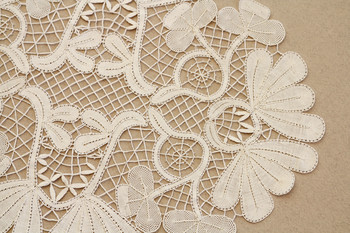Bobbin Lace in the Žiri Area
Bobbin lacemaking knowledge and skills were brought to the Žiri area from Idrija in the second half of the 19th century. It did not take long for the local people to take up this craft, as lace was an interesting marketable product that could provide them with a steady income. The very first shop selling bobbin lace in Žiri was opened in 1896 by Anton Primožič, and in 1906, the Central Lacemaking Course in Vienna founded the Žiri Lacemaking School, which has been in continuous operation ever since.
After World War I, in 1919, the provincial government for Slovenia established the Ljubljana-based Central Institute for Women’s Cottage Industry, which was renamed the National Central Institute for Women’s Cottage Industry in 1929. The institute was active in the field of lacemaking education, production and sale, as well as promotion of Slovenian bobbin lace and lace with national features. New lace patterns either contained national motifs and ornaments or were designed from scratch. In 1938, there were 2,500 lacemakers in the Žiri basin, which was the centre of Slovenian lacemaking.
After World War II, there was a downturn in lacemaking. Women preferred to work at the Alpina footwear factory, where they received social insurance in addition to higher pay for a shorter workday. In the 1980s, there were approximately 250 lacemakers in the Žiri area, while in 1990, there were only around 175 left.
Following the Republic of Slovenia’s declaration of independence in 1991, there was a growing interest in Slovenian heritage and, consequently, bobbin lacemaking. These days, the people in the Žiri area make lace for their own pleasure rather than with the intention of selling it. In order to socialise and improve their lacemaking skills, they founded the Cvetke Lacemaking Society Žiri. Since 2007, the society has been organising the annual Slovenian Days of Lacemaking, where they showcase their lace.
The Cvetke Lacemaking Society Žiri and the Žiri Lacemaking School are among the bearers of Slovenian lacemaking skills and knowledge, which was included in the Register of the Intangible Cultural Heritage of Slovenia in 2015. The greatest recognition of Slovenian and Žiri lacemaking was the inscription of bobbin lacemaking in Slovenia on the UNESCO Representative List of the Intangible Cultural Heritage of Humanity in 2018.
As part of tradition paired with modernity, bobbin lacemaking goes beyond traditional handicrafts, entering the world of contemporary arts and contemporary visual practices, while also preserving the charm of tradition, historical remembrance and national customs, all of which are also a source of its continuous inspiration.
The exhibition is on view at Stara Šola – Stare Žiri cultural centre, Tabor 2, Žiri. It can be visited during the opening hours of the Žiri Library (Monday, Tuesday and Friday: 14.00–19.00, Wednesday: 10.00–15.00).
The exhibition was initiated by the Municipality of Žiri. It was prepared by the Škofja Loka Museum (curator Mojca Šifrer Bulovec) in cooperation with the Cvetke Lacemaking Society Žiri, the Žiri Museum Society and the Žiri Lacemaking School.
The exhibition and the catalogue have been prepared as part of the “Interaktivno in sodobno” project, which was co-funded by the Municipality of Žiri, the European Union from the European Agricultural Fund for Rural Development and the Republic of Slovenia under the Rural Development Programme 2014–2020.

